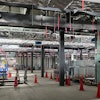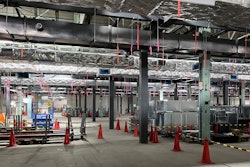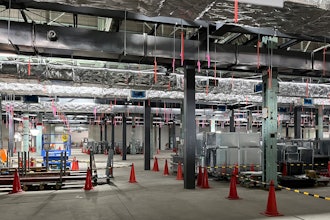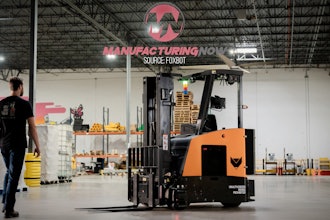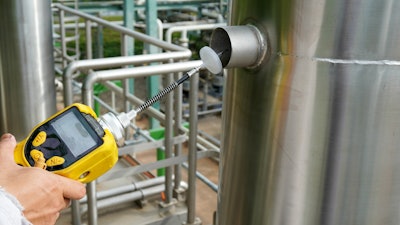
Volatile organic compounds (VOCs for short) are a precursor to ground-level ozone, or smog, which has a hugely negative impact on human health. For that reason, VOCs are heavily regulated by the EPA.
So where do VOCs come from? Many different sources — but one of the primary sources is conventional paints, which has made the coatings industry a major target for regulation.
How Many VOCs? And From Where?
For facility managers, the most important VOC regulations to know are the ones related to architectural coatings. State regulations generally limit the amount of VOCs present in a coating, and they also place an upper limit on the amount of total VOCs a facility can emit in a given year. If a facility emits more than 100 tons of the six major regulated pollutants (of which VOCs are one), then they have to acquire a Title V permit from the EPA — a costly and time-consuming process.
That means that smart facility managers take a two-pronged approach to VOC management; they keep an eye on individual coatings (often the primary source of facility VOCs), and they monitor the total VOCs emitted by their facilities.
This is a high stakes process. If a facility exceeds the VOC limit mandated by the EPA, they have to pay a fine of $1.27 per pound, or $2,500 per ton. A ton of VOCs may sound like a lot, but it’s not unusual for certain coatings to produce two pounds of VOCs per gallon; if you manage a large facility, and use 50,000 gallons of coatings, you’re right up against that 100 ton limit.
A 10% miscalculation can result in 10 excess tons of VOCs — which comes to a $25,000 fine. That’s a significant amount, no matter how large your budget.
These standards are complicated, and it can take years just to master the basics. If you’re managing VOC compliance for a large or mid-sized facility, you should consult an industrial coatings professional to make sure you’re hitting your targets.
 A graphic illustrating what kind of labeling you might look for on a low VOC/high solids paint product
A graphic illustrating what kind of labeling you might look for on a low VOC/high solids paint product
High Solids Coatings: the VOC Solution
Before we can explain what a high solids coating is, we need to touch on the definition of a low solids coating.
A low solids coating like a conventional paint is a mixture of solvents and a binder. The solvents are merely a medium for the binder, which you can think of as the actual coating you’re paying for — but as the paint dries, and those solvents evaporate, VOCs are produced.
A high solids coating, on the other hand, is almost entirely binder — with little or no solvents. Since there’s no solvent to evaporate, there are dramatically fewer VOCs produced during drying.
More of the good stuff, and almost none of the bad stuff. And there are other advantages.
The Pros and Cons of High Solids Coatings
Pros
Fewer Coats for the Same Thickness
A significant portion of a conventional paint is the solvent — which evaporates in the drying process. That means you have to apply several coats to get to a target thickness. High solids coatings barely shrink at all during drying, so you need fewer coats to get the desired thickness.
Highly Resistant — to Everything
If you opt for a 100% solids coating like an epoxy, you’re getting a coating that’s durable and water-resistant. Unlike conventional coatings, they won’t break down from exposure to wind, heat, rain, or cold, and they’re even resistant to harsh chemical cleaners.
No VOCs
We touched on this above, but this is a big one: if you’re trying to lower your VOC output, transitioning from conventional coatings to high solids coatings will hugely reduce your VOCs.
Cons
Quality Can Be Expensive
High solids coatings can be expensive compared to conventional paint. Facility managers should do a careful cost analysis to make sure their benefits are worth the extra expense.
Surfaces Must Be Prepped
You can slap a conventional paint down onto nearly any surface, but a high solids coating, especially an epoxy, requires a cleaned, prepped, and possibly primed surface. Fail to prep the site of the coating properly, and your coating may not form a strong, even bond.
Where Can You Use High Solids Coatings?
High solids coatings have some intriguing real world applications. Let’s touch on a few.
Floors
High solids coatings, especially tough ones like epoxies, are great for floors. They’re the most popular garage floor coatings in U.S. homes, but are also versatile enough for factories and other heavy duty facilities.
Marine Settings
Because epoxies are waterproof and chemically resistant, they’re great for underwater use on boat hulls. Just be sure your other protections don’t clash with your marine coating; some epoxies can’t bond effectively when there’s an electrical corrosion prevention system present.
Food Service
Because high solids coatings like epoxies are resistant to cleaners, water, chemicals, and impacts, they can be ideal for food service settings. They’re also easy to wipe down, and don’t have the unpleasant odors sometimes present with conventional solvent-based coatings.
For Zero VOCs, Think High Solids

Tommy O’Shaughnessy is the owner of Industrial Paint and Protection Magazine, an outlet dedicated to helping facility managers, engineers, and contractors understand the world of industrial coatings.



